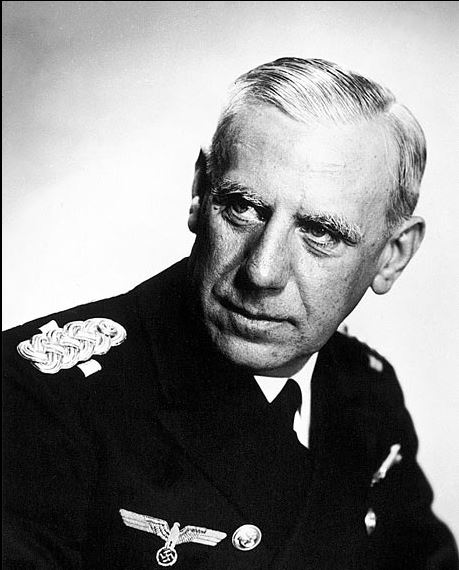In Berlin, running perpendicular to the Tiergarten is Stauffenbergstasse, renamed in honor of Col Claus von Stauffenberg, the man who tried to kill Hitler on 20 July 1944. For on that street stands the Bendlerblock, the wartime headquarters of the German Navy or Kreigsmarine. And it was at the Bendlerbock that Stauffenberg and several of his co-conspirators were lined up and shot following their arrest on 20 July 1944 for their failed attempt to kill Hitler.
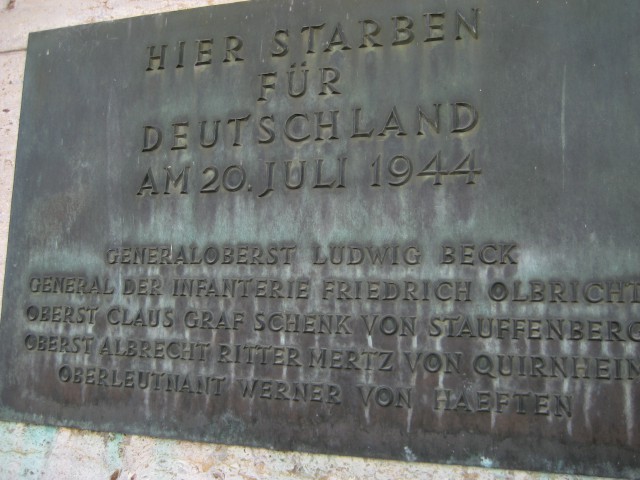

Today, in the Bendlerblock you can find a new fascinating museum. The German Resistance Memorial Center opened just a few years ago and showcases the stories of the Germans who did what they could to resist the Nazis. This museum could never have been built in the immediate years after the war. Those that resisted Hitler were shunned by regular Germans who lived through the war. Many thought the Resistance were traitors who helped bring untold destruction to the Fatherland. Many more couldn’t bear the thought of celebrating them because it raised questions about why they themselves or why their parents weren’t among those who actively resisted Nazism and Hitler.
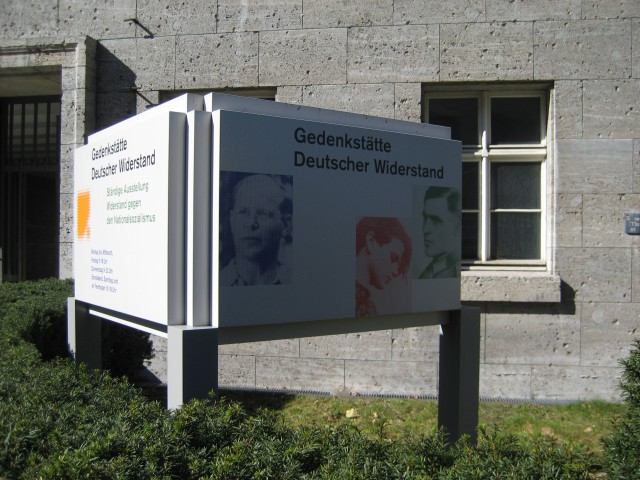
Only now has a new generation taken interest in learning about the Resistance. It took a couple of generations to pass before Germans were ready to contemplate the idea that there actually was an organized Resistance to Hitler and the Nazis and to accept that their grandparents or great-grandparents weren’t a part of it. Unfortunately, with the passage of so many years, information is hard to come by. Surviving family members often changed their names and disappeared into the fog of time. If their fellow countrymen thought they were traitors, most thought it best to just bury the past move on. Very few of the survivors wrote books and most of the personal papers of those captured and killed were burned by the Nazis. Hitler’s narrative was that he was universally beloved by the German people and any evidence to the contrary was to be utterly destroyed.
Indeed, none of the key members of the Resistance were given a real trial. If they were caught, most of them were imprisoned without trial and all of them that remained alive were murdered in April of 1945, just before the war ended. Hitler wasn’t going to allow any of them to survive if he was not going to survive.
As you enter the Bendlerblock and as you climb the staircase to the second floor museum entrance, photos with names line the walls. In many cases, this is all that is left behind as evidence that these people ever existed; people who resisted Hitler and who mostly perished for their efforts. Inside, their stories have been pieced together by the researchers who built the museum. For some, the stories are quite detailed. Many lack all but a few details. And some are barely mentioned at all…….

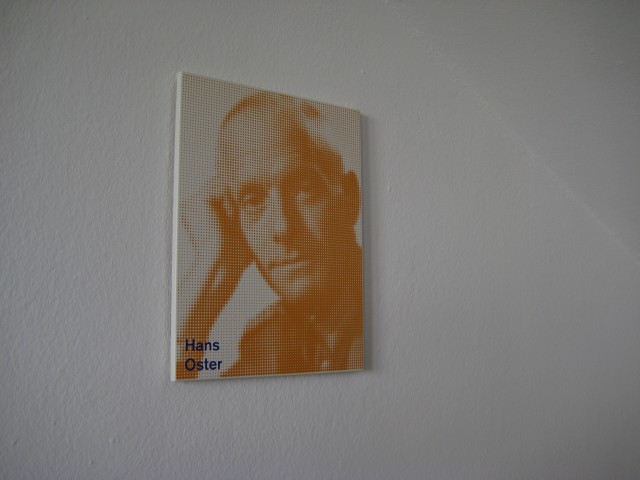
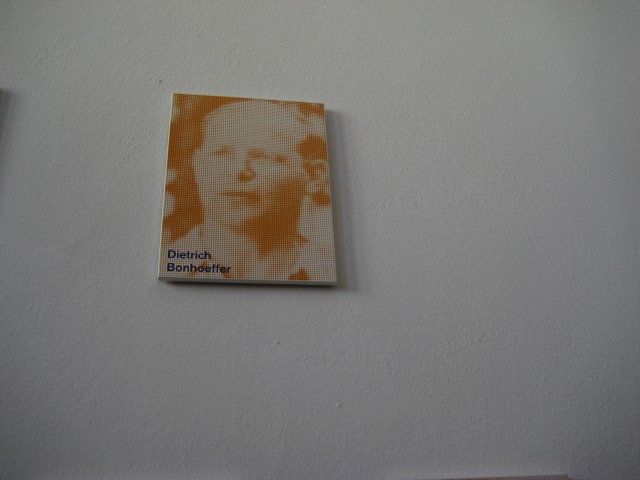
Its hard for anyone to fathom how the head of Germany’s Abwehr or Military Intelligence, could have played such an important role in the resistance to Hitler and Nazism. Most Germans can hardly believe it either. Until his arrest, Adm. Wilhelm Canaris was viewed in Germany as being perhaps the most cunning and ruthless member of Hitler’s inner circle. Hardly a single German would ever have thought that the head of the feared Abwehr was secretly running a double game. While helping to plan many of Hitler’s expansionist schemes, he was also plotting against him, doing whatever he could to thwart Hitler’s plans and in many cases, trying to warn the Allies of Hitler’s intentions in advance. Its a fascinating story. He remains perhaps the biggest mystery man of the Nazi era. A man full of contradictions. He never made a public speech. He rarely spoke at all to anyone but his closest confidants. He had absolute control of the Abwehr and used its power to shelter many members of the Resistance, giving them jobs and the authority and papers necessary to travel around the Nazi Empire. The Abwehr became the epicenter for most of the efforts to thwart the plans of Hitler’s Nazi regime. They schemed for ways to initially depose and arrest him before finally coming to terms with the idea that he had to be killed and they would have to be the ones to organize it. Along the way they used the Abwehr to smuggle Jews out of Berlin to safety and tried to tip off the Allies in many instances to Hitler’s plans and intentions.
Canaris rose to fame during WW1 while serving on the German cruiser, the SMS Dresden as its intelligence officer. In December of 1914, during the Battle of the Falkland Islands in the South Atlantic, the Dresden managed to evade the vastly superior British Navy on numerous occasions. He shrewdly had his contacts on the Argentine mainland sending fake messages from shore to the Dresden talking about where the Dresden should meet coal supply ships to take on fuel. But it was always a ruse and the British fell for it several times. Finally, after several months of cat and mouse games with the British Navy, the Dresden was cornered. The crew scuttled the ship and he, along with the crew, were interned in Chile. But the undaunted Canaris quickly escaped and after a 4 month chase, he managed to return to Germany as hero in October of 1915.
He spoke fluent Spanish and was sent to Spain to work as an intelligence officer. He ended WW1 as a successful U-Boat Captain with nearly 20 credited sinkings.
During the interwar period, when most German officers were forced out of the military, Canaris managed to stay in the German Navy. He developed a nasty reputation and was reputed to have been involved in at least one political assassination of a left wing rival. Although he didn’t join the Nazi Party, most of his friends were members. Perhaps his best friend was Reinhard Heydrich with whom he rode horses in Berlin’s Teirgarten. Canaris and his family often joined Heydrich and his family at backyard dinners.
As Hitler came to power in 1933, Canaris was appointed as the head of the Abwehr, Germany’s military intelligence agency. A few years later, he became a Rear Admiral, a rank and position he held until the end. He immediately set out to develop a spy network in Spain and became a close personal confidant of General Franco.
Up until 1937, it seems that Canaris actively supported Hitler’s actions. Canaris was an avid anti-communist and much of the politics in the interwar period in Europe was dominated by the fight between communism and various forms of capitalism including national socialism.
For some reason that is lost to history, he began to become disillusioned with Hitler around 1937. Perhaps Canaris lost faith with Hitler over the Nazi treatment of the Jews. But its not known with any degree of certainty. What is known is that Canaris and his family had a number of Jewish friends in Berlin where he lived and perhaps he could see what was coming. We only know that something set him on a path to oppose Hitler and that he would become Hitler’s most dangerous enemy. This also put him on a direct collision path with his old friend Reinhard Heydrich who had become the #2 man in the SS under Himmler. Heydrich was a rabid Nazi who became the architect of the Final Solution to rid Europe of its Jewish population.
But by the time of the Czechoslovakia crisis in 1938, Canaris had clearly made up his mind that Germany needed to get rid of Hitler or face ruin. History records that Canaris was warning Hitler not to invade Czechoslovakia as it was going to be “too dangerous”. And Canaris knew exactly what was going on in Czechoslovakia because he was running a spy ring in the Sudetenland using Sudetan Germans to spy on the Czechs. It was here that Canaris would cross paths with the most famous of Sudetan Germans, Oskar Schindler. Schindler became one of the Abwehr’s most important spies in Czechoslovakia until he was captured and imprisoned and sentenced to death by the Czechs. He was only saved from the executioner by Hitler’s successful takeover of Czechoslovakia after which he was freed from prison. There is reason to believe that Schindler’s relationship with the Abwehr continued after he was freed from prison and that it was his connections with Canaris and the Abwehr that provided Schindler with the power he needed to save his list of Jews from certain death in the concentration camps of Plaszow, Auschwitz and later from Gross-Rosen. 1
1
After Czechoslovakia, Canaris seems to have ramped up his anti-Nazi efforts. He began hiring into the Abwehr, a large number of fellow thinking Germans who also opposed Hitler.
Chief among these was Gen. Hans Oster. Oster was vehemently opposed to Hitler. Long before the war began, Oster was going from one top Wehrmacht General to another trying to whip up anti-Hitler sentiment. They eventually banned him from the General Staff Headquarters so that they wouldn’t have to listen to him anymore. Oster became an early advocate of killing Hitler rather than just deposing him. And he became Canaris’ deputy at the Abwehr.
Joining them were a number of other key players in the Resistance including General Erwin Lahousen, the head of Austria’s military intelligence and a prewar friend of Canaris. It was Lahousen who would train the agents sent by the Abwehr to the US during the middle of the war. Perhaps this explains why they all got rounded up within hours or days of their arrival.

Also joining the Abwehr was a Lutheran Minister named Dietrich Bonhoeffer. Bonhoeffer left the Lutheran Church in disgust over its support of Hitler’s anti-Jewish policies. In fact, the entire Bonhoeffer family became involved in the Resistance including his brother-in-law, Hans von Dohnányi, who also joined the Abwehr. Dohnanyi was a attorney who unfortunately thought it would be a good idea to keep a giant file of all the Nazi’s transgressions. This file would fall into the hands of Himmler’s Gestapo and would lead to the demise of them all.
Perhaps the greatest contribution that Canaris made to the Allied war effort came right at the start of the war. Canaris, who had become a close personal friend to Spain’s Gen. Franco during the Spanish Civil War, travelled there to convince Franco to resist Hitler’s demands that Spain allow German troops to transit through Spain to capture Gibraltar. Canaris knew that if Gibraltar fell, then all the British troops that had to be supplied through the Gibraltar Straits by ship could never survive. Hitler would have dominated the Mediterranean. Malta would have been indefensible. There would have been no way for the British in Egypt to resist Rommel’s Afrika Corps and nothing would have stood in Rommel’s path from Tunisia all the way to Saudi Arabia where the British derived nearly all of their oil supply.
Canaris traveled to Poland after the invasion in September of 1939 and saw first hand what Himmler and Heydrich and the SS were doing. He was so incensed with what he saw that he went to Gen. William Keitel, the head of the General Staff and demanded that it stop. He warned Keitel that the world would one day hold the Wehrmacht responsible for the murderous acts in Poland. Keitel’s response was to tell Canaris to return to the Abwehr and say no more about it.
It wasn’t long before detailed information concerning Nazi atrocities began leaking out. Canaris arranged to use one of his agents, another anti-Nazi named Dr. Josef Muller, a devout Catholic, to get the information into the hands of the Vatican in Rome. These reports made their way to British intelligence. Similarly, Canaris organized another path of communications through Dietrich Bonhoeffer who met secretly in Sweden with his prewar friend, George Bell, the Bishop of Chichester and the Dean of Canterbury. Bonhoeffer also told Bell about the growing anti-Nazi efforts inside Germany and of Hitler’s intentions. Bell became another conduit to British Intelligence.
Now entering this story is Sir Stuart Menzies, the head of MI-6. With all these reports seemingly originating from the Abwehr, it was up to Menzies, the head of British Intelligence to decide what to do with the information. Was it good information? Or was it disinformation? Could these stories of a bunch of anti-Nazi’s running the Abwehr really be true? Or was it a ruse designed to fool the British into doing something stupid? Menzies knew that Canaris was a cagey and clever adversary. How could he trust Canaris when his reputation for outfoxing the British during WW1 was so well known? As with many things that have to do with Canaris, its not clear how much Menzies trusted the information he was receiving through Mueller and Bonhoeffer. And after the war, it would have been embarrassing to admit to the public that British Intelligence may have missed a chance to help the anti-Nazi’s either depose or kill Hitler and end the war in 1940 or 1941. So even the Allies chose after the war to say very little about the Resistance to Hitler. Menzies MI-6 files have yet to be opened to historical review. It may take many more years before this side of the story is better understood.

Shortly before Heydrich was assigned to Prague in 1942, the SS and SD under Himmler began to grow suspicious of the Abwehr and Canaris. Himmler tried to have the Abwehr placed underneath his control but Canaris managed to keep this from happening. However, it was becoming clear to Canaris that his old friend Heydrich was now his enemy. The story of the assassination of Heydrich by the Czech resistance does not, as of today, include any connection to Canaris. But it is clear that with the demise of Heydrich, much of the pressure on the Abwehr from Himmler and the SS began to die away, at least for awhile. As such, knowing that Canaris was in contact with British Intelligence, it would not be stretch to believe that he had something to do with the plan to kill Heydrich. History records that the plot was hatched in London by the Czech government in exile and British Intelligence. If Canaris was involved, it will take the opening of MI-6’s archives to reveal it. .
What is known is that Sir Stuart Menzies met with Canaris on several occasions in Lisbon and in Spain during the war. What was discussed remains shrouded in secrecy. We do know that several of the attempts on Hitler’s life during the course of war were carried out with British explosives and British detonators including the July 1944 plot. Perhaps these attempts to kill Hitler were the subject of the meetings. We also know that many in the Resistance thought that if they could depose or kill Hitler, the Western Allies might agree to negotiate a separate peace deal that would allow Germany to keep fighting the Russians in the east. But this was a dream that many in the Wehrmacht secretly and sometimes openly also dreamed about. Either of these subjects could have been the topic of discussion between Canaris and Menzies.
Canaris was also secretly trying to tip off the allies about Hitler’s intentions. He warned the Allies that Hitler was going to invade Poland using Muller and Bonhoeffer. Again he warmed them that Hitler was going to invade Western Europe through the low countries and into France. But each warning was viewed as being a cunning trick and each time the warning was ignored.
In April of 1943, Canaris made contact with George Earle, the former governor of Pennsylvania who Roosevelt had sent to Istanbul to be his personal spy to gather information about the Balkans. Canaris showed up on his doorstep to pitch the idea of a separate peace deal directly to the Americans. But just as the contacts through Menzies failed to achieve anything, neither did an appeal directly to Roosevelt via Earle. And of course, to the Allies, it could indeed have been nothing more than a trick. Either way, the only answer ever given by Churchill or Roosevelt was that the Allies would only accept unconditional surrender.

As the war dragged on, the actions of the Resistance to Hitler grew more and more desperate. In late 1943, during an attempt to smuggle some of their Jewish friends out of Berlin to safety in Switzerland, Oster and the Jews were arrested by the SS trying to board a train out of Berlin. Canaris cooked up a tall tail that the SS was interfering with an Abwehr intelligence mission as the Jews were actually trained Abwehr agents being sent to Switzerland and then to America. But they had a little trouble explaining to the SS why it was necessary for entire family, including children and grandparents, to go along. Himmler was getting more and more suspicious. Eventually, after the July plot to kill Hitler, Himmler and the SS managed to find Donyanyi’s extensive notes about Nazi atrocities. This brought even more focus onto the Abwehr and Canaris as the purpose of Danyanyi’s notes were hard to explain.
They managed to all keep their jobs until the end of 1944 when Canaris, Oster, Bonhoeffer,and Donyanyi would all end up in the cells under the Gestapo building on Prinz Albrechtstrasse.
In February of 1945 Canaris and a number of others were sent to the concentration camp at Flossenburg, near the Czech border. Here they were tortured and starved until 9 April, 1945 when they were marched out of their cells and hung just a few weeks before the end of the war. The camp was liberated only 2 weeks later by the US Army on 23 April 1945.
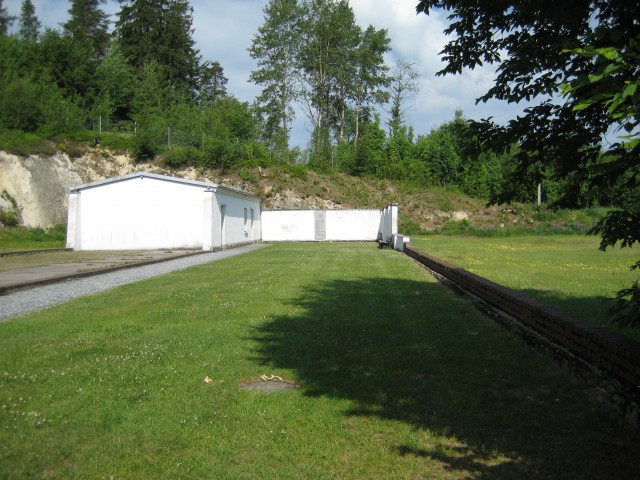
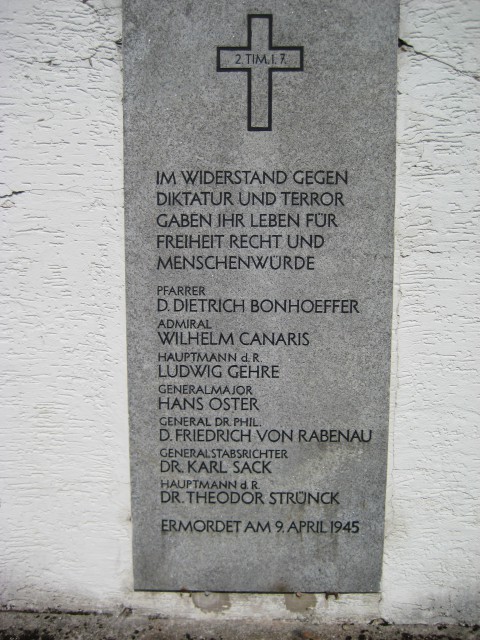
One of Canaris’ fellow prisoners at Flossenburg was the former Director of Danish Military Intelligence, Col. Lunding. He occupied the cell next to Canaris. On the morning of his murder, Canaris told him by tapping out morse code on the wall,
“This is the end. Badly handled. My nose broken. I have done nothing against Germany. If you survive, please tell my wife.”
Lunding recalled after the war watching the naked Admiral being led to his execution.
Another member of the Abwehr who managed to escape to Switzerland and survive the war, Hans Gisevius, wrote of his friend Adm. Canaris, in a book in 1947 “To The Bitter End”,
“Canaris hated not only Hitler and Himmler, but the entire Nazi system as a political phenomenon .. He was everywhere and nowhere at once. Everywhere he traveled, at home and abroad and to the front, he always left a whirl of confusion behind him.”
….
And as you walk around in the Bendlerblock Museum, you may find something quite odd that that museum. Almost completely absent from all the photographs and names and stories is none other than… Admiral Wilhelm Canaris. Maybe the Admiral would smile thinking that he once again was keeping them guessing?
You can see more of Richards excellent work here www.richardmbrook.com
